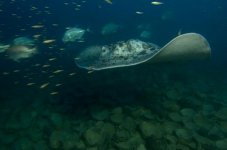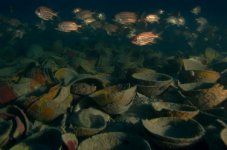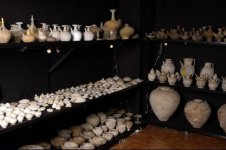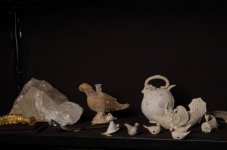Cyril Roger Brossard
Well-known member
- Joined
- Aug 30, 2012
- Messages
- 408
This is a bit old and I am not sure if this was discussed before.
Found here.
Discover the fabulous treasure of Ciberon

It is a treasure that would be the envy of any archaeologist, any treasure hunter. Precious stones, imperial ceramics, jewelries, gold, crystal ... A total of 271,000 objects dating from the 10th century, retrieved from a galleon wrecked off the port of Cirebon (Java), Indonesia, will soon be auctioned in Jakarta. Minimum Value: $ 80 million. First sale took place on May 5 in the halls of the Ministry of Fisheries and Maritime Affairs of the capital, but no bidder was present. Culprit: the modalities of participation. Each candidate, including museums in China, Singapore or Taiwan, would drop $ 16 million. Nobody has done in the allotted time.

That afternoon, in the huge reception hall of the Ministry, the three hammer blew, announcing the failure of the auction, resonated as a victory for opponents of the sale. Mingled with dozens of journalists, one of them cheered and waved a placard that he informed his displeasure to see this treasure, a symbol of wealth leave the country. He will be called before the authorities decide the indefinite postponement of the sale. Standing, Luc Heymans, Belgian director Cosmix Underwater Research the company behind the discovery in 2004, does not hide his bitterness. "I'm obviously disappointed. This sale would close five years of work and expertise; we should probably review the methods of participation. But there are interested customers, these pieces are unique and perfect state of preservation" he says.

A few days earlier, Luc Heymans, 52, gave us an appointment in the storage area where the objects found at Cirebon are stored. The place, located in the outskirts of Jakarta, is highly monitored. We must show our credentials to enter the stud farm, transformed for the occasion into a temporary museum. The stables of horses are now occupied by hundreds of boxes containing treasures thousand years old. "Each piece has been identified, measured, appraised and cataloged. We know each of them, "he says. The hundreds of thousands of Chinese porcelain brought to the surface time for most of the period of the "Five Dynasties" (906-960). "We have very little evidence of the time, this is a major discovery, one of the largest ever conducted for several years." The bottom of the stud, Luc Heymans recreated a treasure room, accessible only to potential customers: we see shelves full of the most beautiful parts of the boat anchor, amphorae, vases, sculptures, but also in good custody, 4000 rubies, 12,000 pearls, crystal blocks, gold jewelry and coins polished glass, dating from the time of the Fatimids from Egypt, Iran, Syria or Mesopotamia. "This is evidence that trade was prosperous at that time in Indonesia. It came from the Middle East or China, it was a busy road. We do not know where this boat was gone and where he went, what seems certain is that it sank because of a cargo too heavy, "he says.

The discovery of this treasure is a soap opera plot twists worthy of a Hollywood blockbuster. The first episode began at the end of 2003. At the time, two fishermen in their nets were recovered pieces of ceramics. This discovery would quickly come out, and Luc Heymans, who was prospecting in the area, the site was entrusted with another company specializing in underwater archaeological research. The first excavations, carried out in April 2004, are optimistic. The boat, which does bear name, measure 36m long, 11m broad based and it’s cargo lay by 57 m deep. "Research has been highly regulated. Permit excavation we had been given by an organization of 13 departments, including Fisheries, Culture and Finance. Even on the boat, we had representatives to monitor the cargo, "recalls Luc Heymans. The excavations were interrupted six months later for verification. They will resume in January 2005 for ten months with the rise of more than 270,000 pieces. 75 people, including teams of divers, archaeologists and French, Belgian, German, American, Australian, participate in research. "Everything was done in perfect agreement with the authorities, the objects were returned to Jakarta where they were cleaned and recorded on DVDs with all of their data."

The trouble begins at the end of 2005 when a competitor denounced the actions of the company Luc Heymans. According to her, the Cosmix plunder Indonesian Heritage underwater and would not all permissions. The judicial machine starts. Seals are installed on the boat, parts, stored in a house in Lebak Bulus in South Jakarta, were seized and two divers, one French and one German, are placed in custody. "They will be released no later than 43 days until the situation clears. We had all the paperwork in order, this discovery has sparked envy and many wanted to appropriate, "said Luc Heymans.

For three years, the parts have been careful appraisals performed at the Royal Museum of Mariemont, Belgium. Were analyzed, sampled in order to trace their history. Even the ship was recreated in three dimensions. "It was to better understand what happened, who were for these parts. Ceramics were surely embassies, precious stones were used as offerings to Buddha, the remainder was used in trade or pageantry. There was a lot of sultanate in the region. "At the next auction, items will be sold in one lot. The future buyer will own the entire cargo of Cirebon. 1000 years later, this discovery continues to fascinate many.
Link to the website of the Mariemont Museum in Belgium. The page can be seen in English!
And also from here.
Indonesia treasure auction fails to attract bidders
A 10th Century treasure from the wreck found off Cirebon, Java
An Indonesian auction of more than 270,000 treasures recovered from a 10th Century Chinese shipwreck has failed to attract a single bidder.
Organisers had hoped the sale would raise $80m (?52.7m), which would have been one of the largest sums raised at auction in the country.
Officials said there had been some 20 expressions of interest but no-one paid the $16m deposit required to bid.
They said a second sale would be held at a later date.
The treasure, found on a 10th Century Chinese ship off the coast of West Java in 2004, is believed to be one of the largest troves ever found in Asia.
In total some 271,000 items were being offered at the sale in the capital, Jakarta.
"Ceramics account for about 90% of the findings" Aris Kabul, secretary of the auction committee had told Reuters.
" How do you expect people to decide in five days to put $16m on the table? " Luc Heymans, treasure hunter
Others items include delicate jewel-studded gold jewellery, crystal ware and swords with Arabic inscriptions.
The amount raised was to have been split equally between the government and the treasure hunters who retrieved the goods from the sunken ship.
"The cost of the removal of the goods from the ancient shipwreck was $10m" said Mr Sudirman, Indonesia's Director General of Maritime, Coastal Areas and Small Islands.
"Indonesia doesn't have the resources to be able to remove these sorts of underwater treasures by ourselves."
Belgian treasure hunter Luc Heymans, who was involved in the salvage operation and was to receive some of the revenue from the sale, said he was not surprised the auction failed.
'Hefty deposit'
"The problem is the regulations. I didn't really expect people to come and deposit $16m" he told the AFP news agency.
"Also the timing, the announcement was only five days before the auction. How do you expect people to decide in five days to put $16m on the table? It's a lot of money."
The BBC's Karishma Vaswani in Jakarta says $16m was a hefty price for the organisers to ask for, but they had only wanted serious buyers to attend the sale.
Maritime Affairs Ministry official Ansori Zawawi told AFP the second attempt would take place under new conditions - it was not certain whether the deposit system would remain in place.
Found here.
Discover the fabulous treasure of Ciberon

It is a treasure that would be the envy of any archaeologist, any treasure hunter. Precious stones, imperial ceramics, jewelries, gold, crystal ... A total of 271,000 objects dating from the 10th century, retrieved from a galleon wrecked off the port of Cirebon (Java), Indonesia, will soon be auctioned in Jakarta. Minimum Value: $ 80 million. First sale took place on May 5 in the halls of the Ministry of Fisheries and Maritime Affairs of the capital, but no bidder was present. Culprit: the modalities of participation. Each candidate, including museums in China, Singapore or Taiwan, would drop $ 16 million. Nobody has done in the allotted time.

That afternoon, in the huge reception hall of the Ministry, the three hammer blew, announcing the failure of the auction, resonated as a victory for opponents of the sale. Mingled with dozens of journalists, one of them cheered and waved a placard that he informed his displeasure to see this treasure, a symbol of wealth leave the country. He will be called before the authorities decide the indefinite postponement of the sale. Standing, Luc Heymans, Belgian director Cosmix Underwater Research the company behind the discovery in 2004, does not hide his bitterness. "I'm obviously disappointed. This sale would close five years of work and expertise; we should probably review the methods of participation. But there are interested customers, these pieces are unique and perfect state of preservation" he says.

A few days earlier, Luc Heymans, 52, gave us an appointment in the storage area where the objects found at Cirebon are stored. The place, located in the outskirts of Jakarta, is highly monitored. We must show our credentials to enter the stud farm, transformed for the occasion into a temporary museum. The stables of horses are now occupied by hundreds of boxes containing treasures thousand years old. "Each piece has been identified, measured, appraised and cataloged. We know each of them, "he says. The hundreds of thousands of Chinese porcelain brought to the surface time for most of the period of the "Five Dynasties" (906-960). "We have very little evidence of the time, this is a major discovery, one of the largest ever conducted for several years." The bottom of the stud, Luc Heymans recreated a treasure room, accessible only to potential customers: we see shelves full of the most beautiful parts of the boat anchor, amphorae, vases, sculptures, but also in good custody, 4000 rubies, 12,000 pearls, crystal blocks, gold jewelry and coins polished glass, dating from the time of the Fatimids from Egypt, Iran, Syria or Mesopotamia. "This is evidence that trade was prosperous at that time in Indonesia. It came from the Middle East or China, it was a busy road. We do not know where this boat was gone and where he went, what seems certain is that it sank because of a cargo too heavy, "he says.

The discovery of this treasure is a soap opera plot twists worthy of a Hollywood blockbuster. The first episode began at the end of 2003. At the time, two fishermen in their nets were recovered pieces of ceramics. This discovery would quickly come out, and Luc Heymans, who was prospecting in the area, the site was entrusted with another company specializing in underwater archaeological research. The first excavations, carried out in April 2004, are optimistic. The boat, which does bear name, measure 36m long, 11m broad based and it’s cargo lay by 57 m deep. "Research has been highly regulated. Permit excavation we had been given by an organization of 13 departments, including Fisheries, Culture and Finance. Even on the boat, we had representatives to monitor the cargo, "recalls Luc Heymans. The excavations were interrupted six months later for verification. They will resume in January 2005 for ten months with the rise of more than 270,000 pieces. 75 people, including teams of divers, archaeologists and French, Belgian, German, American, Australian, participate in research. "Everything was done in perfect agreement with the authorities, the objects were returned to Jakarta where they were cleaned and recorded on DVDs with all of their data."

The trouble begins at the end of 2005 when a competitor denounced the actions of the company Luc Heymans. According to her, the Cosmix plunder Indonesian Heritage underwater and would not all permissions. The judicial machine starts. Seals are installed on the boat, parts, stored in a house in Lebak Bulus in South Jakarta, were seized and two divers, one French and one German, are placed in custody. "They will be released no later than 43 days until the situation clears. We had all the paperwork in order, this discovery has sparked envy and many wanted to appropriate, "said Luc Heymans.

For three years, the parts have been careful appraisals performed at the Royal Museum of Mariemont, Belgium. Were analyzed, sampled in order to trace their history. Even the ship was recreated in three dimensions. "It was to better understand what happened, who were for these parts. Ceramics were surely embassies, precious stones were used as offerings to Buddha, the remainder was used in trade or pageantry. There was a lot of sultanate in the region. "At the next auction, items will be sold in one lot. The future buyer will own the entire cargo of Cirebon. 1000 years later, this discovery continues to fascinate many.
Link to the website of the Mariemont Museum in Belgium. The page can be seen in English!
And also from here.
Indonesia treasure auction fails to attract bidders
A 10th Century treasure from the wreck found off Cirebon, Java
An Indonesian auction of more than 270,000 treasures recovered from a 10th Century Chinese shipwreck has failed to attract a single bidder.
Organisers had hoped the sale would raise $80m (?52.7m), which would have been one of the largest sums raised at auction in the country.
Officials said there had been some 20 expressions of interest but no-one paid the $16m deposit required to bid.
They said a second sale would be held at a later date.
The treasure, found on a 10th Century Chinese ship off the coast of West Java in 2004, is believed to be one of the largest troves ever found in Asia.
In total some 271,000 items were being offered at the sale in the capital, Jakarta.
"Ceramics account for about 90% of the findings" Aris Kabul, secretary of the auction committee had told Reuters.
" How do you expect people to decide in five days to put $16m on the table? " Luc Heymans, treasure hunter
Others items include delicate jewel-studded gold jewellery, crystal ware and swords with Arabic inscriptions.
The amount raised was to have been split equally between the government and the treasure hunters who retrieved the goods from the sunken ship.
"The cost of the removal of the goods from the ancient shipwreck was $10m" said Mr Sudirman, Indonesia's Director General of Maritime, Coastal Areas and Small Islands.
"Indonesia doesn't have the resources to be able to remove these sorts of underwater treasures by ourselves."
Belgian treasure hunter Luc Heymans, who was involved in the salvage operation and was to receive some of the revenue from the sale, said he was not surprised the auction failed.
'Hefty deposit'
"The problem is the regulations. I didn't really expect people to come and deposit $16m" he told the AFP news agency.
"Also the timing, the announcement was only five days before the auction. How do you expect people to decide in five days to put $16m on the table? It's a lot of money."
The BBC's Karishma Vaswani in Jakarta says $16m was a hefty price for the organisers to ask for, but they had only wanted serious buyers to attend the sale.
Maritime Affairs Ministry official Ansori Zawawi told AFP the second attempt would take place under new conditions - it was not certain whether the deposit system would remain in place.
Last edited:
